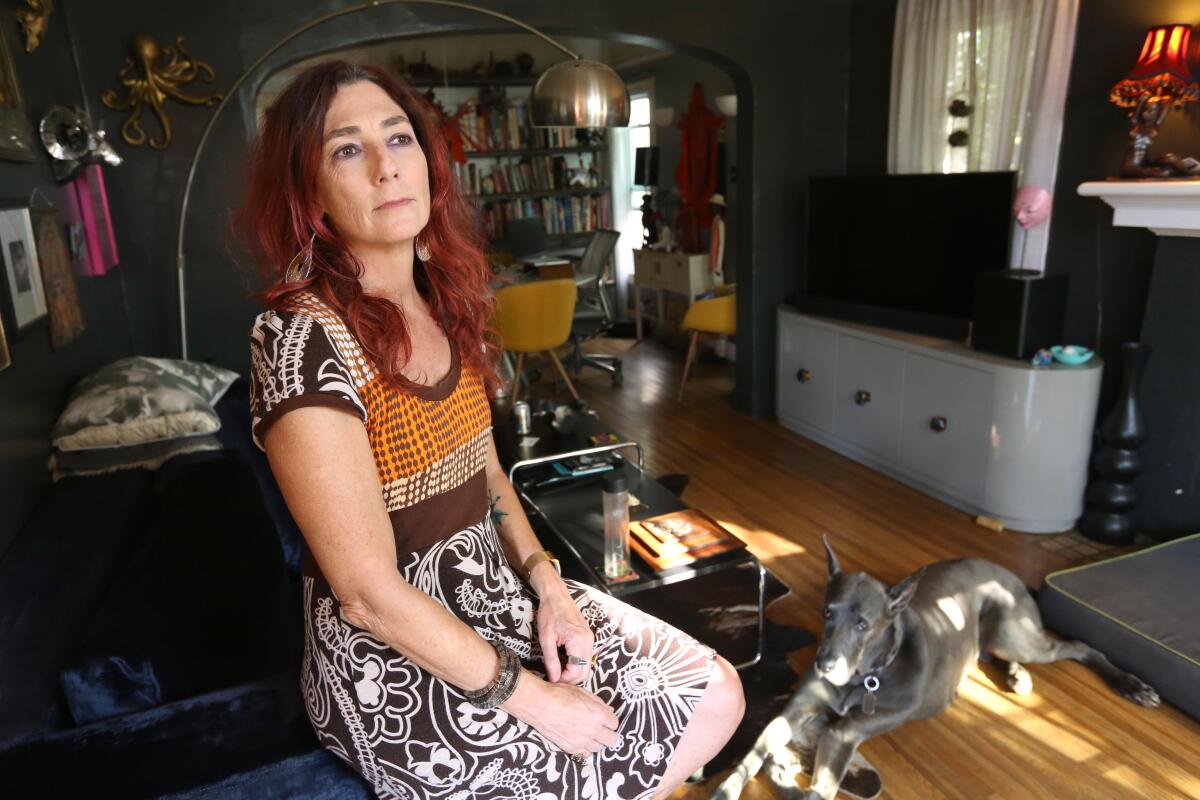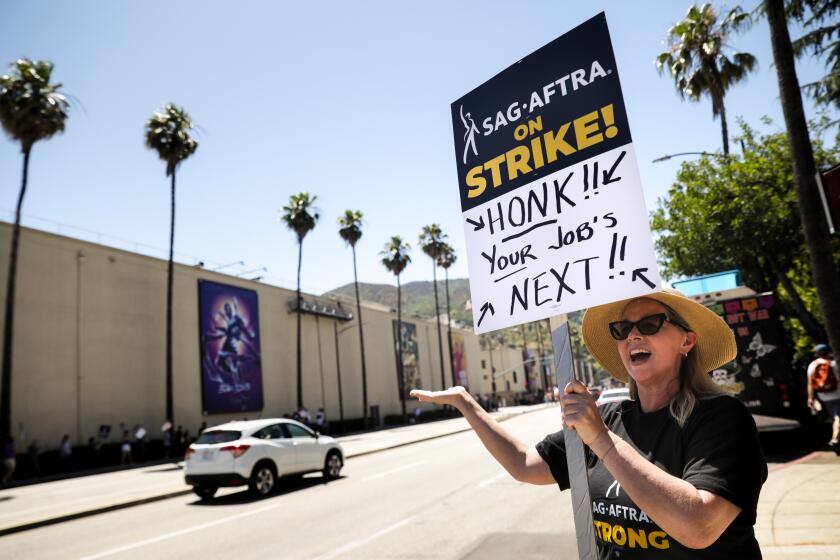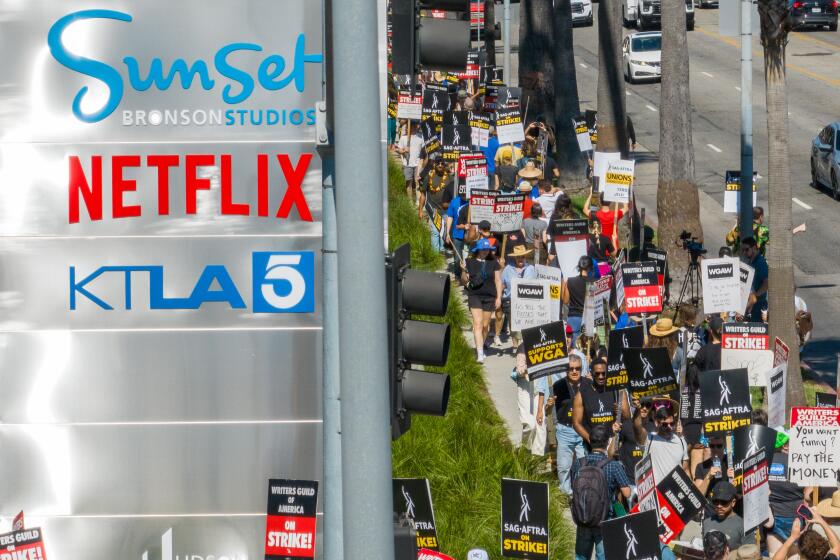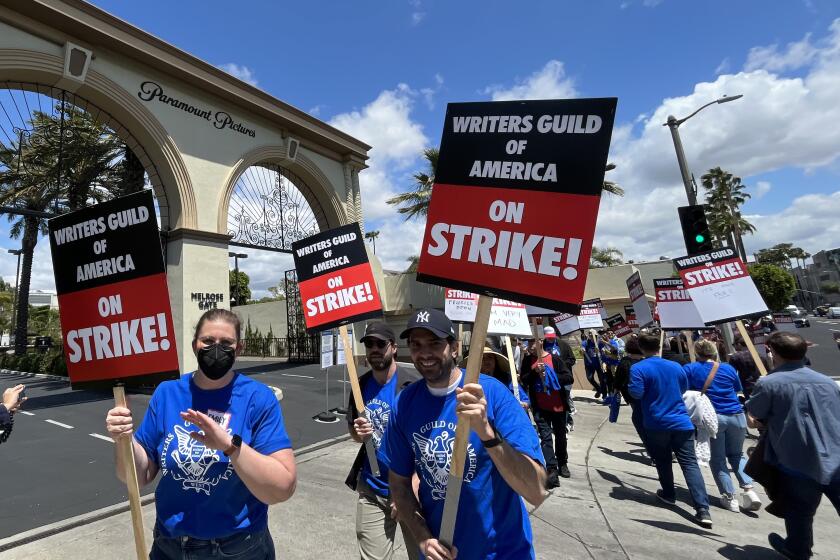Not just writers and actors: Crew workers struggle through Hollywood’s summer of strikes

- Share via
For a quarter of a century, Andi Brittan has worked steadily as a set decorator on movies and TV shows, but as Hollywood began to slow down this year in anticipation for what has become known as the summer of labor strife, she hasn’t worked a single production job.
Mid-City-based Brittan’s most recent big show was Prime Video’s Emmy-nominated “Daisy Jones & the Six” last year. To make ends meet, she has been taking on side gigs, like teaching set decorating to high schoolers. “It’s been a huge struggle,” she said. “At this moment, I’m not really making ends meet.”
Despite the personal financial hardship, Brittan, 52, refuses to cross a picket line. “I feel like this is a fight worth fighting for,” Brittan said. “It’s not just for the writers, it’s for all of us.”
Brittan is among the tens of thousands of film and TV workers caught in the crosshairs as the battle between Hollywood studios and writers and actors over streaming pay, working conditions, artificial intelligence and other issues has ground Hollywood to a halt.
She is the set decorator representative and a delegate for the International Alliance of Theatrical Stage Employees Local 44 — the IATSE union represents people working in crafts such as costuming, makeup and film editing. They keep Hollywood humming. For these workers, many already financially vulnerable, the historic double strike has been challenging.
Actors are striking against the major Hollywood studios for the first time in 43 years. Here’s what to know.
“The strike is causing a lot of turmoil in the IATSE membership because it’s not our contract, and yet we are being affected by it as if it was our strike,” said Max Schwartz, a set lighting technician and member of the Local 728.
Los Angeles-based Schwartz was working on the second season of the Issa Rae-created comedy “Rap Sh!t” on Max when he began socking away money after he heard rumblings that the writers were poised to strike. “I take these things very seriously,” he said.
Although Schwartz, 33, whose credits include the films “Nope” and “Clemency,” as well as the truTV comedy series “Tacoma FD,” saved enough to keep him afloat for three months, he noted that given the current impasse and strident comments from both sides, the strike may outlast his savings.
“I personally will start to feel hardship after three months,” he said. “If there’s no work, if there’s no end to this in sight.”
An unequivocal supporter of the actions taken by the WGA and SAG-AFTRA, nevertheless, Schwartz has begun contemplating selling his belongings, including his golf clubs and his “Magic: The Gathering” card collection, as “a buffer.”
“The economic fallout for below-the-line crewmembers is real,” said IATSE President Matthew D. Loeb in a message posted on the union’s website. “If the studios truly cared about the economic fallout of their preemptive work slowdown against below-the-line crewmembers, they could continue to pay crewmembers and fully fund their healthcare at any moment, as they did in 2020 during the onset of the COVID-19 pandemic.”
The Alliance of Motion Picture and Television Producers (AMPTP) declined comment. SAG-AFTRA didn’t respond to a request for comment.
Inspired by the success of Netflix, Hollywood studios pursued Silicon Valley-style hypergrowth with tactics borrowed from the likes of Uber and Lyft.
The AMPTP, which represents the major studios in bargaining with the unions, has said it offered the actors a deal worth $1 billion that included historic pay rises. The studios blamed SAG-AFTRA for walking away from negotiations, leading to financial hardship for people who depend on the industry.
WGA and SAG-AFTRA have said the studios did not meaningfully engage on key issues they were fighting for, a charge that the AMPTP has vigorously disputed. “Our strike, SAG-AFTRA’s strike, and all the disruption that has happened to our industry has been caused by the studios’ refusal to share their success with the workers who build their business,” the WGA said in a statement. “Members of IATSE, Teamsters, Laborers, and all Hollywood unions have joined and honored our picket lines, often at great personal cost. Hollywood would not exist without its workforce, and when we are united, we will win.”
In an emotional speech earlier this month, SAG-AFTRA President Fran Drescher acknowledged the effect that opening a strike on a second front would have across the industry. “We made the hard decision that we tell you as we stand before you today,” Drescher said. “This is major. It’s really serious, and it’s going to impact every single person that is in labor.”
Indeed, since July 7, the Motion Picture & Television Fund (MPTF), which provides temporary funding and a set of health and social services to working and retired members of the entertainment community, has received more than 2,500 calls for financial assistance, mostly from the below-the-line workers, according to a statement from the nonprofit.
The current writers’ strike is just the latest in Hollywood. Since the 1950s, writers gone on strike eight times.
In an effort to help, following the writers’ strike, IATSE said it would donate $2 million to charities to support its members. The union said the funds have been earmarked for the MPTF, the Entertainment Community Fund (formerly the Actors Fund) and the Actors’ Fund of Canada.
Others have stepped up to offer assistance.
Prop master Alicia Haverland is spearheading the formation of a charity called Drive 4 Solidarity that will help film and TV workers, providing them with financial assistance from $500 to $2,500. “So many of our members just don’t have anywhere to go,” Haverland said.
On July 15, the Union Solidarity Coalition, founded by a group of writers and directors, held an event featuring the rock band Fishbone at the Berrics, a skatepark near downtown L.A., to raise healthcare funds for crew members affected by the strike.
Hundreds of writers, actors, IATSE members and non-industry supporters purchased raffle tickets for the chance to see Taylor Swift in concert, enjoyed tricks and illusions from magicians or danced to ’90s hip-hop despite a heatwave hitting the city. The group raised $190,182.
James Eddy, a 51-year-old prop master who recently worked on HBO’s “The Sympathizer,” said his phone stopped ringing for new work last October. Typically he would get a couple of calls a month seeing if he was free, but the industry went quiet months before the strike as the industry prepared, he said.
As SAG-AFTRA members join writers on picket lines, the fallout will disrupt Hollywood film and TV productions worldwide. ‘There’s going to be blood in the water,’ said one analyst. ‘This will not end well.’
“Normally, you can grab your next show before you’re even finished with the one you’re currently on,” he said. “But there was no work out there.”
Eddy does qualify for disability insurance for work injuries to help make ends meet, but otherwise he estimates he has about three months left in savings and predicts he may have to move from his Studio City home. “I can’t really afford the rent without a job,” Eddy said. “All I can do is stay optimistic.”
Many businesses linked to the film industry are suffering too, with some having to enact layoffs or cut back on paid work hours. Last week, Sony Pictures shuttered its Culver City prop house in response to the number of productions shut down.
Even before the writers went on strike, the industry in Los Angeles had registered multiple quarters of slowing production following a wave of studio cutbacks and fears of an impending walkout. By summer, scripted production had come to a near stop.
It is estimated that during the 100-day writers’ strike in 2007-2008, the Los Angeles economy took a $2.1 billion hit and lost 37,700 jobs directly and indirectly tied to the entertainment industry, according to an analysis by the Milken Institute.
This time around, some experts predict the costs could outstrip that work stoppage.
“These conditions will potentially produce an absolute collapse of an entire industry,” said Barry Diller, a former chairman of Paramount Pictures, on CBS’ “Face the Nation.”
Lesli Lytle, 59, a set dresser and script supervisor for 28 years, echoed Diller’s chilly prognosis. An active member of IATSE Local 871 and Local 44, Lytle has worked on shows such as “Big Shot,” “Westworld” and “Lethal Weapon,” experiencing the industry’s highs and lows.
But the current double strike has left her concerned.
“I’ve never been this scared about the industry,” she said. “I’m afraid of losing everything that I built since 1995 — and it’s the career that goes behind it.”
Lytle has been out of work for the last six months, recovering from knee surgery. As a result, she lost her health insurance and doesn’t qualify for assistance. Now, the ongoing strikes have placed Lytle in an even more precarious situation. “It’s this huge circle that just eats itself from the tail to the head and keeps going,” she said.
The crush of circumstances has left Lytle considering food bank assistance as well as possibly selling off some of her signed movie memorabilia and pieces of antique furniture her parents left her. She also said she might rent out the second bedroom in her Glendale apartment that she has been using as a craft room.
And yet she is unequivocal in her support of the striking writers and actors, and in her blame of the studios. “We deserve to have a slice of that pie instead of your shareholders who did nothing to create that content,” she said.
Times staff writer Kenan Draughorne contributed to this report.
More to Read
Inside the business of entertainment
The Wide Shot brings you news, analysis and insights on everything from streaming wars to production — and what it all means for the future.
You may occasionally receive promotional content from the Los Angeles Times.















